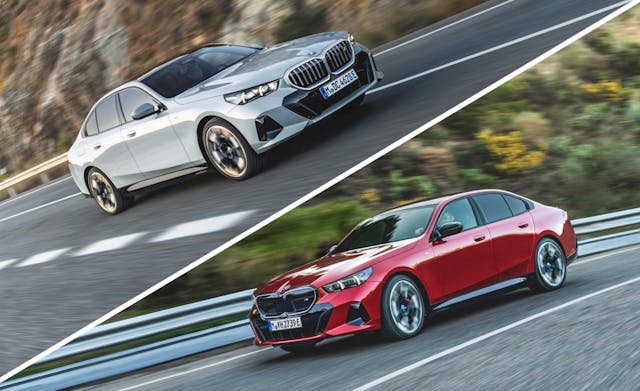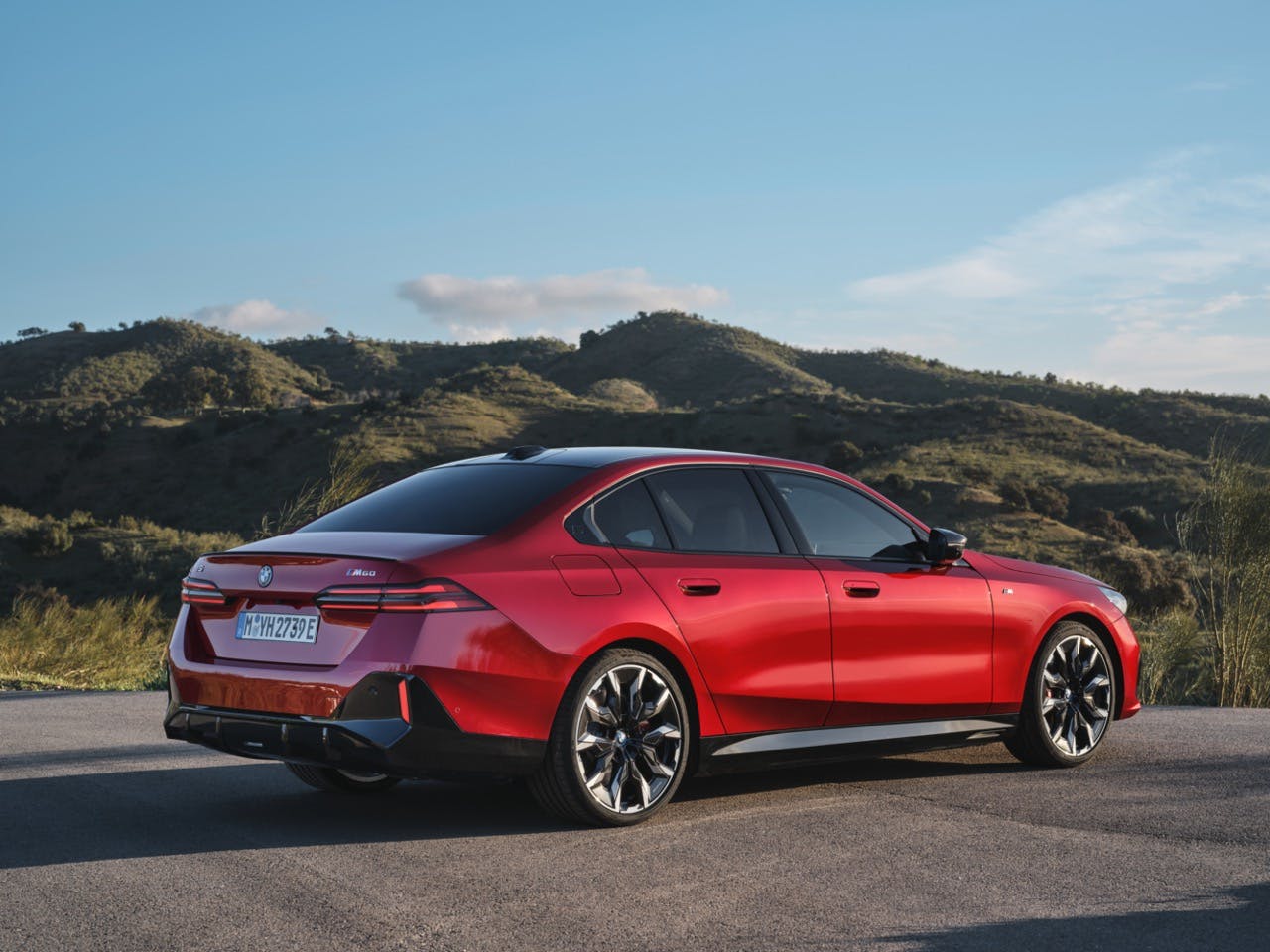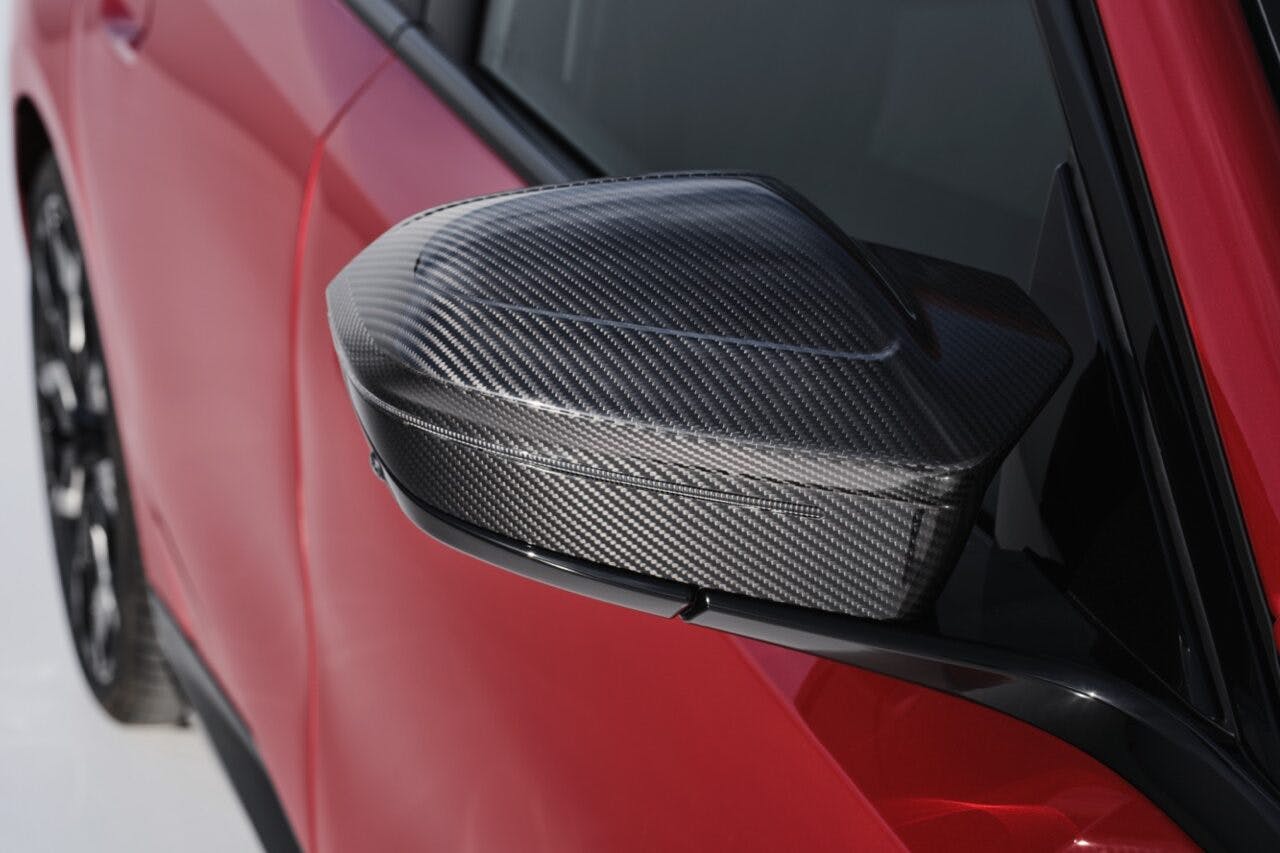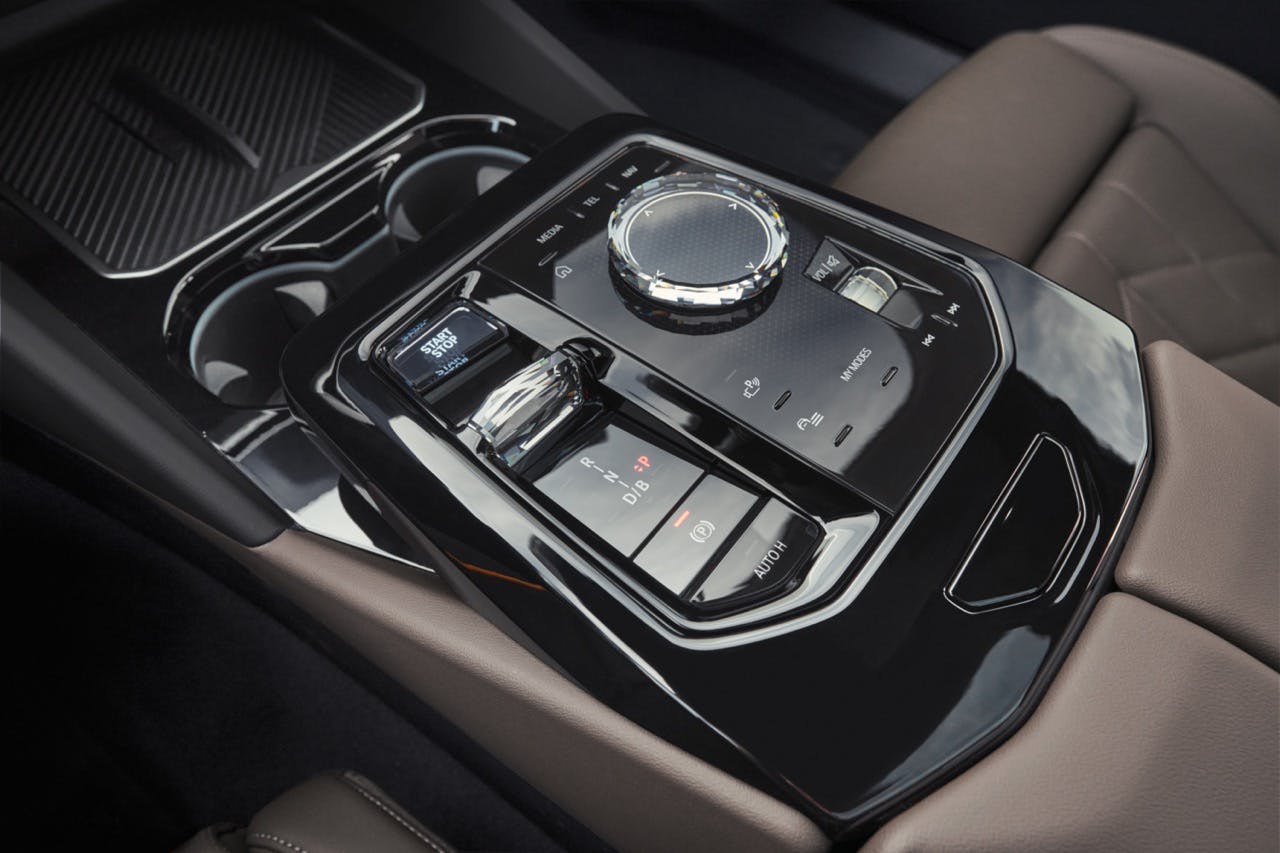BMW i5 First Drive: Electric 5 Series mostly nails the brief
BMW hasn’t screwed it up. Isn’t that a relief?
If you’re an enthusiast, and I’d assume you are if you’re on this website, then it’s probably in your best interest to forget that cars like the BMW XM exist. But the 5 Series is core BMW stuff, so if the company had got this one wrong, people would be out in the streets burning Bavarian flags. But, to put your mind at ease, the new fünfer is reassuringly good.
Specifically, the BMW i5, since alongside combustion models, this is the first generation of 5 Series to be offered in fully electric form. There are two models to start with: the rear-wheel-drive eDrive40 and the all-wheel-drive M60 xDrive, with an in-between xDrive40 arriving a little later down the line.
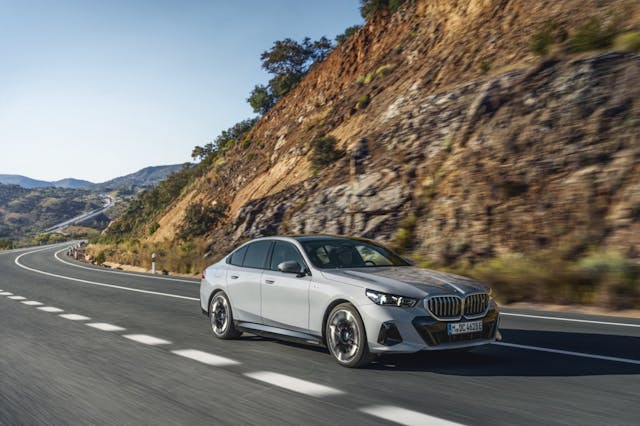
The i5 eDrive40 is the base model, though it’s not expected to be the core model in the way the gas 530i will be. Cost is a factor; the i5 eDrive40 starts at $67,795, or about $9000 higher than the jumping-off point for the range as a whole.
That said, there won’t be much comparison between the gas and electric entry points. The eDrive40 gets a 335-hp, 317 lb-ft electric motor mounted at the rear axle, compared with 255 hp and 295 lb-ft for the 530i and its 2.0-liter turbo four-cylinder. A bit like Porsche Taycan pricing overlapping with the Panamera, this should see more than a few people giving the i5 a whirl purely out of curiosity.
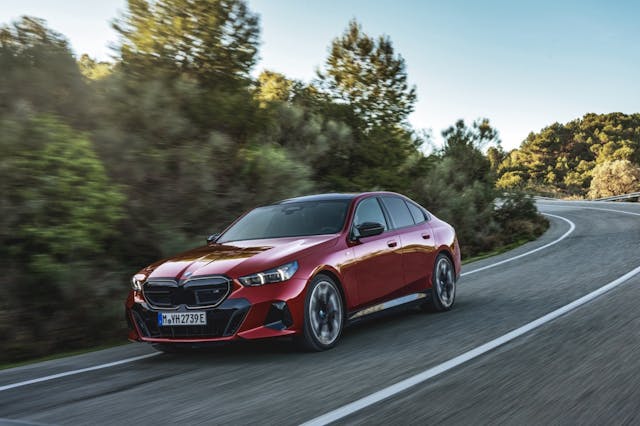
Specs: 2023 BMW i5 eDrive40 & M60 xDrive (U.S.)
Price: $67,795; $85,195
Engine: Single; dual electric motors
Transmission: Single-speed, rear-wheel drive; all-wheel drive
Power: 335 hp; 593 hp
Torque: 295 lb-ft; 586 lb-ft
Weight: 4915 pounds; 5247 pounds
Range: 295 miles; 256 miles
0–60mph: 5.7 sec; 3.8 sec
Top speed: 120 mph; 130 mph
Topping the entire range, meanwhile, is the dual-motor M60 xDrive (335 hp at the rear, 258 hp at the front, for a quoted 593 hp total). That makes it easily the most powerful and accelerative of any new 5 Series—until an M5 arrives at some point—and the outgoing one of those was about $112,000. Basically, everything’s quite expensive these days.
Styling? It’s not bad, really. In fact, the i5 is less divisive than some other recent BMWs. The front, as ever, will take the most getting used to (with or without opting for M Sport Pro trim on the M60, which illuminates the perimeter of the kidneys). The back’s simply standard modern BMW, while the side profile is most interesting, with a down-sloped trunk lid of the kind we haven’t seen on a 5 Series since the E28 generation.
The proportions do a good job of hiding the new i5’s size—this is now a 16-and-a-half-foot-long car—though we noticed a styling quirk of the flat sides, which almost make the doors look like they’re bowing out when the light catches them a certain way. It’s as if the panel gaps sit in slight valleys. You’d not get that on an Audi, is all we’ll say on the matter. Large wheels help visually shrink the car, too; the eDrive40 we drove was on 20-inchers, also offered on the M60. (The 20s come at a slight range penalty.)
The i5 is arguably most appealing from the inside out. The layout and materials riff on the larger 7 Series and i7, and as soon as your derriere hits the “Veganza” artificial leather, the seats have the same astonishingly soft and comfortable feel as those in the i7. The difference in the i5 is that you sit lower in the car, and you can get lower still if you wish, as there’s enormous adjustment in both the seat and the steering wheel.
The dash layout is similar to that of many modern BMWs: A widescreen display incorporating both the driver’s instruments and the infotainment screen, and the latter is both touch-sensitive and can be operated by the glistening crystal iDrive knob between the seats, a device whose design reminds us of the old glass ashtrays you used to get in pubs, turned upside down.
As ever, the infotainment is a bottomless pit of features, most of which are best investigated before you move off, if you wish to spend any time with your eyes on the road. Luckily, frequently used stuff like climate control settings can be prodded quickly and accurately on the move, and there are various shortcut buttons around the iDrive ashtray, none of which are quite as tactile since they’re rendered in piano black plastic, a substance nobody seems willing or able to banish from automotive interiors. There’s less of it in the back, but more space than ever, thanks to the car and its wheelbase growing for this generation.
There’s little drama to starting either i5, as we’ve come to expect with EVs, but it doesn’t take much of a press on the accelerator pedal to hear futuristic noises emanating from the speakers, part of a collaboration between BMW and movie composer Hans Zimmer. They’re nice enough; we didn’t feel compelled to turn them off, and they really only come into play when you’re accelerating hard.
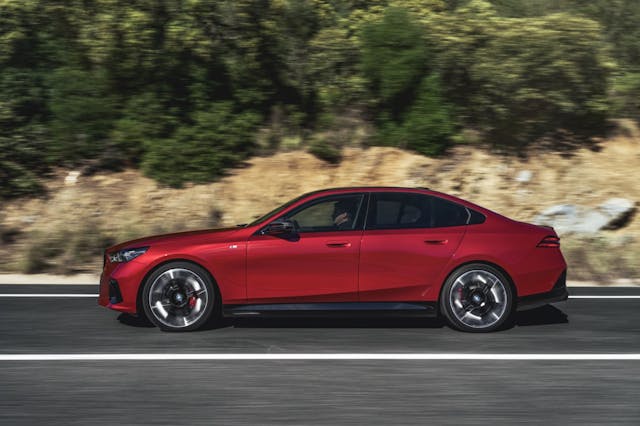
That’s something both cars will happily do. The eDrive40 gets from 0–62 mph in 6 seconds dead, and the M60 in 3.8. Even with only its rear wheels driven, the eDrive40 finds plenty of traction off the line, and with a quick ramp-up of power so it doesn’t turn all four tires into smoke, the M60 really launches hard; if you’re not a Tesla or Taycan regular, it’s enough to make you blurt out a few expletives the first time you give it a try.
A “Boost” paddle behind the left-hand steering wheel spoke gives an extra hit of torque, which is also fun but shows BMW has clearly reined in the ultimate performance of both cars. Basic, everyday things like getting the holeshot in converging lanes or overtaking Ethel in her Honda Fit feel like you’re entering Verstappen’s weekend wheels into a Formula Ford race. Still, this should not disappoint the 5 Series faithful.
Nor should handling. These are heavy machines, and it takes some time to wrap your head around a 5 Series that weighs, as a minimum, 2.5 tons. The much-beloved E39-generation 5er was under 3750 pounds at its lightest, a whole Caterham Seven less than the i5. But you’ll also struggle to wrap your head around the way it doesn’t at all drive like such a porky car, with abundant grip and next to no body roll.
The eDrive40 and the M60 actually feel very similar, even though the latter has adaptive dampers and the ability to decouple its anti-roll bars in a straight line to the benefit of ride quality. Both have impressive agility for their size and weight, neither complains at fairly quick changes of direction, and they obviously have the power to surge out of corners as if they have no inertia.

At normal road speeds, this resolute control of their faculties does leave them feeling a little aloof, particularly given the steering doesn’t relay many messages beyond a gentle increase in weight in quicker turns, and its natural accuracy and response. It actually leaves you thankful for the M Sport suspension settings, which renders the ride quality just tense enough that you notice what’s going on underneath, without it being actively uncomfortable, though it means really rough sections can jostle you around a little. High-speed refinement, though, is predictably excellent: little road or suspension noise, the merest rustle of wind, and obviously next to nothing from the drivetrain.
The roads of our test weren’t of the kind to really put braking under strain, but BMW has blended regenerative and friction braking well enough that you’ll rarely curse pedal feel, while the regen itself varies on the road, depending on where you are, whether you’re following someone, and other predetermined scenarios. Lift off on a motorway and you’ll likely coast (for a really long time—the i5 has a drag coefficient of around 0.22, so it barely seems to shed speed), but do the same approaching a 35-mph zone from a 65-mph zone, and the motors will harvest energy to slow you down. It’s more intuitive than it sounds.
Regen brings us on to efficiency, and with a usable 81-kWh of battery capacity, the eDrive40 is claimed to do 295 miles on a charge, with the M60 slightly less at 256 miles. Real-world range will likely be a little lower, but it’s enough to make either more useful than a Taycan or Audi e-tron GT, if not a Tesla Model S or Mercedes EQE. Both i5 models support 205-kW fast charging, so a 10–80 percent top-up takes as little as half an hour, and if you’re low on juice, a 10-minute fill can gain you as much as 100 miles.
So, to reiterate, BMW hasn’t screwed up with the i5. If you’re good with the looks and the general concept of owning an electric car, then there’s a lot here to like. A classic 5 Series will still involve you more as a driver but you knew that already; a more pertinent comparison is that the i5 is nearly as good to drive as a much more expensive Porsche Taycan, but more accommodating and it goes further on a charge, for less initial outlay. And it leaves us wondering: Would an all-electric M5 be such a bad thing?
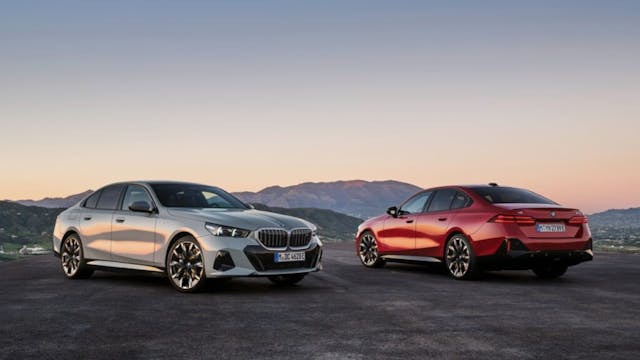
2023 BMW i5 eDrive40 & M60 xDrive
Highs: Excellent acceleration, generous room in the back row, relatively restrained styling for a modern BMW.
Lows: Immense weight, uncommunicative steering, brittle ride over imperfect roads.
Summary: The i5 is the perhaps the best all-electric BMW we’ve seen yet, evolving the 5 Series reputation for luxury and performance that punches way above its price point.
***
Check out the Hagerty Media homepage so you don’t miss a single story, or better yet, bookmark it. To get our best stories delivered right to your inbox, subscribe to our newsletters.
